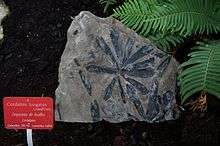Cordaites
For the explosive, see Cordite.
| Cordaites Temporal range: Late Carboniferous | |
|---|---|
 | |
| Cordaites lungatus | |
| Scientific classification | |
| Kingdom: | Plantae |
| Division: | Coniferophyta |
| Class: | Pinopsida |
| Order: | Cordaitales |
| Family: | Cordaitaceae |
| Genus: | Cordaites |
| Species | |
| |
Cordaites is an important genus of extinct gymnosperms which grew on wet ground similar to the Everglades in Florida. Brackish water mussels and crustacea are found frequently between the roots of these trees. The fossils are found in rock sections from the Upper Carboniferous (323 to 299 million years ago) of the Dutch - Belgian - German coal area. A number of many noteworthy types from this line are:
- Cordaites principalis
- Cordaites ludlowi (named after Ludlow, a coal area in England)
- Cordaites hislopii. Found in Paleorrota geopark in Brazil.[1]
In contrast to many other plants, Cordaites seeds are not rare, because they are rather large (up to 10 mm); those seeds are named Cordaicarpus.
References
- ↑ Karen Adami-Rodrigues, Paulo Alves De Souza, Roberto Iannuzzi & Irajá Damiani Pinto (2004), "Herbivoria Em Floras Gonduânicas Do Neopaleózoico Do Rio Grande Do Sul: Análise Quantitativa" (PDF), Revista Brasileira de Paleontologia, 7 (2): 93–102
External links
- http://www.uni-muenster.de/GeoPalaeontologie/Palaeo/Palbot/seite18.html
- http://museum.gov.ns.ca/fossils/gallery/specimen/967206.htm
- http://www.xs4all.nl/~steurh/engcord/ecordai.html
- Image of a Cardiocarpus fossil
This article is issued from Wikipedia - version of the 9/14/2016. The text is available under the Creative Commons Attribution/Share Alike but additional terms may apply for the media files.